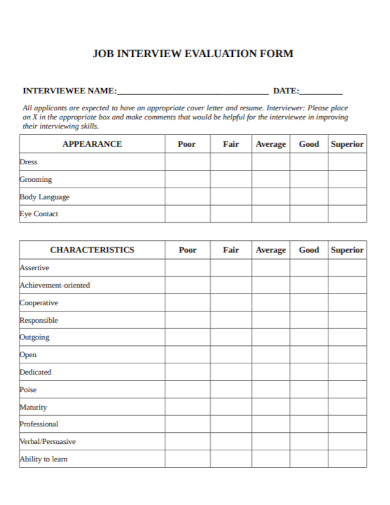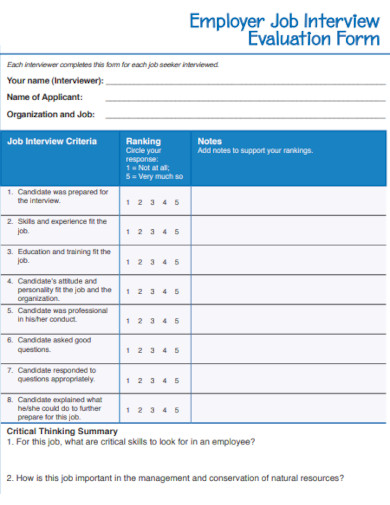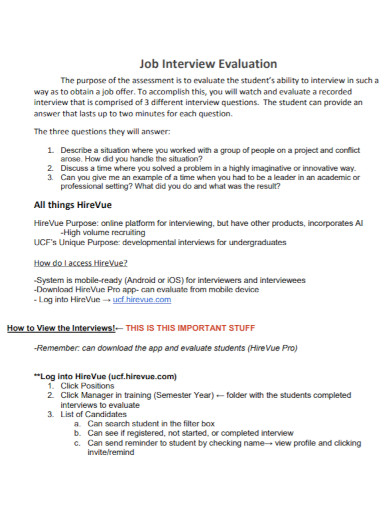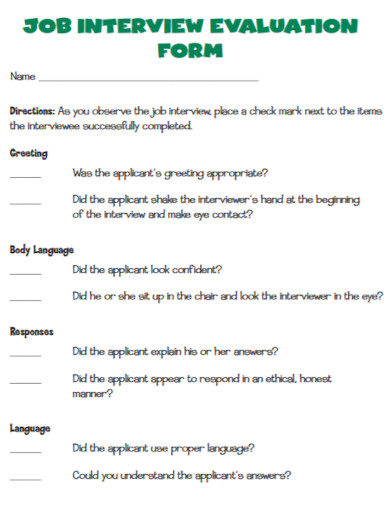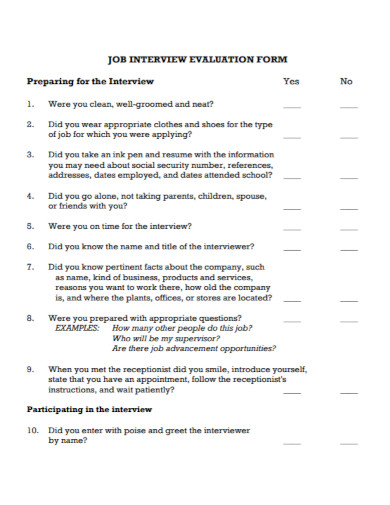5+ Job Interview Evaluation Examples
Whether you are new to the employment world or you already know the ropes, there is still that feeling of nervousness when it comes to hearing the word job interview. To some, there is even a worse kind of feeling when they get to hear job interview evaluation. This is understandable since regardless if you are a rookie or you know the ropes already, you will still feel that nervous feeling when you encounter this. A job interview alone can be scary, but what if there’s an evaluation after it? This is actually a normal case for any kind of company who is hiring, and going through interviews. They need to evaluate the person. As this is part of their company policy and a requirement as well. But wait, there’s more! If you want to know what a job interview evaluation is, what its purpose may be and how to do or what to expect in a job interview evaluation, I suggest you scroll down and check the information below.
5+ Job Interview Evaluation Examples
1. Job Interview Evaluation Form
2. Employer Job Interview Evaluation
3. Job Interview Evaluation Template
4. Job Interview Evaluation in PDF
5. Standard Job Interview Evaluation
6. General Job Interview Evaluation
What Is a Job Interview Evaluation?
During a job interview, the first thing an interviewer may think would be about an applicant’s physical attributes. Most job interviewers often think that if you have the look, you may as well have the smarts. But this is not always the case. When a job interview is done, the evaluation is placed to remove any prejudice they may have for the job applicant, whoever the job applicant may be before they stepped into the interview room. Rather than focusing on the physical attributes a person has, they will now rely on the rubrics of the evaluation given. This means they would be basing their evaluation based on the skills, job experience, educational background, attitude and knowledge of the applicant.
This is now based on the rubrics that they have set out instead of focusing on favoring whom they believe is a right fit for the company and for the position they are applying for. In addition to that, the evaluation is also a useful tool when it comes to knowing more about what a person can give rather than on what the interviewer may assume by the features of a certain person.
How to Write a Job Interview Evaluation?
Where do you begin when you are planning on writing a job interview evaluation? Do you begin by writing the applicant’s name? Then what’s next? If you are curious as to how a job interview evaluation would look like, check out the following tips below for more. Also remember this, how you plan on writing your job interview evaluation depends on you.
1. Know Your Criteria
By now, you should at least have a criteria you have in mind for your job interview evaluation. Your criteria can range from educational background to work experience. Your criteria should at least have something related to the job and the position they may be applying for.
2. Give a Rating for Each Criteria
Give a rating for each criteria you place. The rating depends on you of course. The most common one is a rating of 1 as the lowest and 5 as the highest. Some job interview evaluations also have a comment after every rating. As always this depends on who is writing the evaluation and how you are going to write it.
3. General to Specific
Give a general to specific type of criteria. Place in each table the general criteria and break it into something specific. This way it is easier for you to evaluate the applicant who may possess certain skills. In addition to that, it is also going to be easier for you to be able to know that this applicant has the skills that could be useful for the position they are applying than to simply place the general skills on your paper.
4. Add Some Comments
Add some both positive and negative comments. If possible, make them the same number. This is to help the applicant know where they may be lacking and can improve. As well as where they excel and can also improve on that. Your comments can be very helpful to an applicant who may either pass the interview and move forward or may need to find another and can use the comments as a way to improve themselves.
5. Be Professional
As you do the evaluation, the most important thing to remember is to be professional. Being professional means you are not going to say anything or write anything rude in the comments about the interviewee. Being professional means you are going to listen to them talk while you do your evaluation.
FAQs
What is a job interview evaluation?
A kind of evaluation wherein the interviewer evaluates the candidate through a series of skills that are listed down. The applicant is then rated for each skill they may possess.
What is the purpose of a job interview evaluation?
The purpose of the job interview evaluation is to eliminate the prejudice of the interviewer about the applicant. Rather than judging the applicant for their looks, they are now basing it on their skills, knowledge and work history just to name a few.
Why is it necessary to add comments?
The comments help the applicant know where they excel and where they need improvement. It is also a way to keep notes on the applicant if they pass the interview.
A job interview evaluation is a useful tool when it comes to assessing, analyzing and evaluating the applicant. It does not only show the skills that the applicant may possess, you are also able to give out a critical rating to see if the applicant knows what they are doing. This tool is also quite helpful as this helps out the interviewer with giving them comments for each or for the general skill that they may have rated lower.



